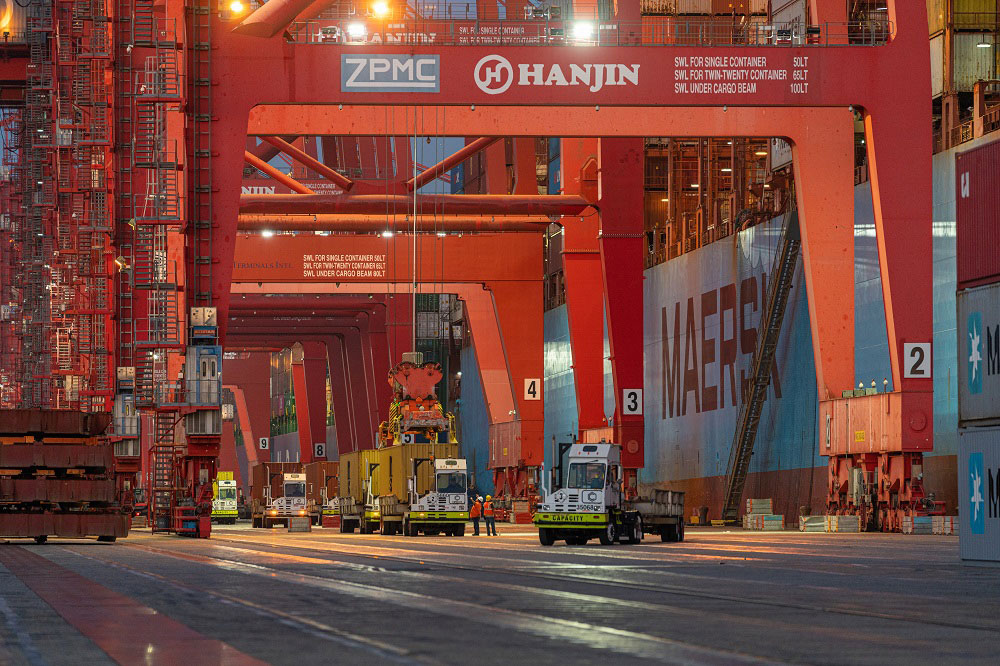Do automated LA and Long Beach container terminals generate more work and higher pay for ILWU?

Automated container terminals at the Ports of Long Beach and Los Angeles have generated more work hours and higher pay for longshore workers according to a report commissioned by the Pacific Maritime Association (PMA).
The report entitled “Terminal Automation in Southern California: Implications for Growth, Jobs, and the Future Competitiveness of West Coast Ports” was authored by Dr. Michael Nacht and Larry Henry.
The PMA report was harshly criticized by an International Longshore and Warehouse Union (ILWU) official as hiding the impact of job losses caused by automated operations at the Ports of Long Beach and Los Angeles.
Automation will be a major issue as the ILWU and PMA negotiate a new contract agreement for West Coast ports.
The findings by the authors argue that automated terminals already increase the competitiveness of the Ports of Los Angeles and Long Beach: “As a result, cargo handling has grown rapidly, and paid hours for ILWU workers at LBCT (Long Beach Container Terminal) and TraPac (located at the Port of Los Angeles) were 31.5% higher in 2021 than in 2015, before the transition to automation began … That is more than twice the 13.9% growth in paid hours at San Pedro Bay’s non-automated terminals. Rather than reducing work for ILWU members, automation has raised demand for their services.”
“… paid hours at the two automated terminals rose 31.5%, compared to 13.9% at the non-automated terminals, driven by efficiency gains that more than doubled the number of containers processed by these two terminals. Moreover, the adoption of automation has provided workers with opportunities to be retrained and upskilled for new jobs as port operations evolve.”
During the 2020-2022 supply chain crisis impacting the two Southern California ports, there was a huge spillover of containers that had to be stored on and off terminals as a result of delays in loading and unloading ships. However, the two automated terminals were far more efficient than conventional containers in processing containers on a per acre basis: “Automation at Long Beach Container Terminal (LBCT) and TraPac is driving much-needed efficiency and productivity gains – benefiting ILWU workers. Between January 2020 and February 2022, throughput rose to an average of 510 TEUs per acre, compared to about 350 TEUs per acre at San Pedro Bay’s conventional container terminals. LBCT and TraPac also processed containers up to twice as fast.”
Enhancing Competitiveness
In an interview with AJOT, co-author Michael Nacht, recently retired as the chair of the Policy Focus Area for the Nuclear Science and Security Consortium at the University of California Berkeley, said automated terminals are enhancing competitiveness at Los Angeles and Long Beach.
Nacht said he benefitted from the collaboration of co-author Larry Henry, a founder of ContainerTrac, Inc. The company provides automated in-yard container inventorying systems for seaport and rail industries.
Nacht said, the two authors noted the following progress at automated terminals at the Ports of Long Beach and Los Angeles: The founding president of the ILWU Harry Bridges negotiated the Mechanization and Modernization Agreement of 1960 resulting in West Coast dock workers accepting the right of employers to introduce labor-saving technology: “Bridges was very far-sighted in anticipating the revolution in international trade caused by the container” that gave U.S, West Coast ports and dockworkers a dominant role in processing containerized cargoes from Asia. As much as 40% of U.S. imports have been processed at the ports of Los Angeles and Long Beach.
New jobs at the automated container terminals require that longshore workers be retrained to handle new jobs “in data analysis, software development and maintenance of equipment. But with these skill requirements comes higher pay.”
Higher pay accompanies these jobs because “the improvement in productivity motivates employers to reward workers with high pay to keep them happy and so its’s a win/win situation for workers and employers.”
The benefit for the automated terminals is “you can track containers at the terminal, and you don’t lose them in stacks the way you can with conventional containers especially where there is an overflow. The automated systems also allow for more compact stacking, and this is why you see automated terminals handling 510 TEUs per acre as opposed to 350 TEUs per acre at conventional terminals.”
Automated terminals are run with zero-emission electrical equipment which eliminates the diesel pollution generated at conventional terminals. This reduces health risks to surrounding communities and advances the implementation of zero emission terminals operations as support by the Clean Air Action Plan supported by the Ports of Los Angeles and Long Beach.
In their report the two authors note that conventional terminal operators have been slow to adopt full automation because it requires capital investment of billions of dollars. It can take 15 years or more to implement and, therefore, to pay off through productivity gains, despite lowering relative labor costs. As a result, some terminals opt to automate only some cargo-handling functions. U.S. terminal operators, in particular, have the added hurdle of resistance from labor unions.
© Copyright 1999–2024 American Journal of Transportation. All Rights Reserved


